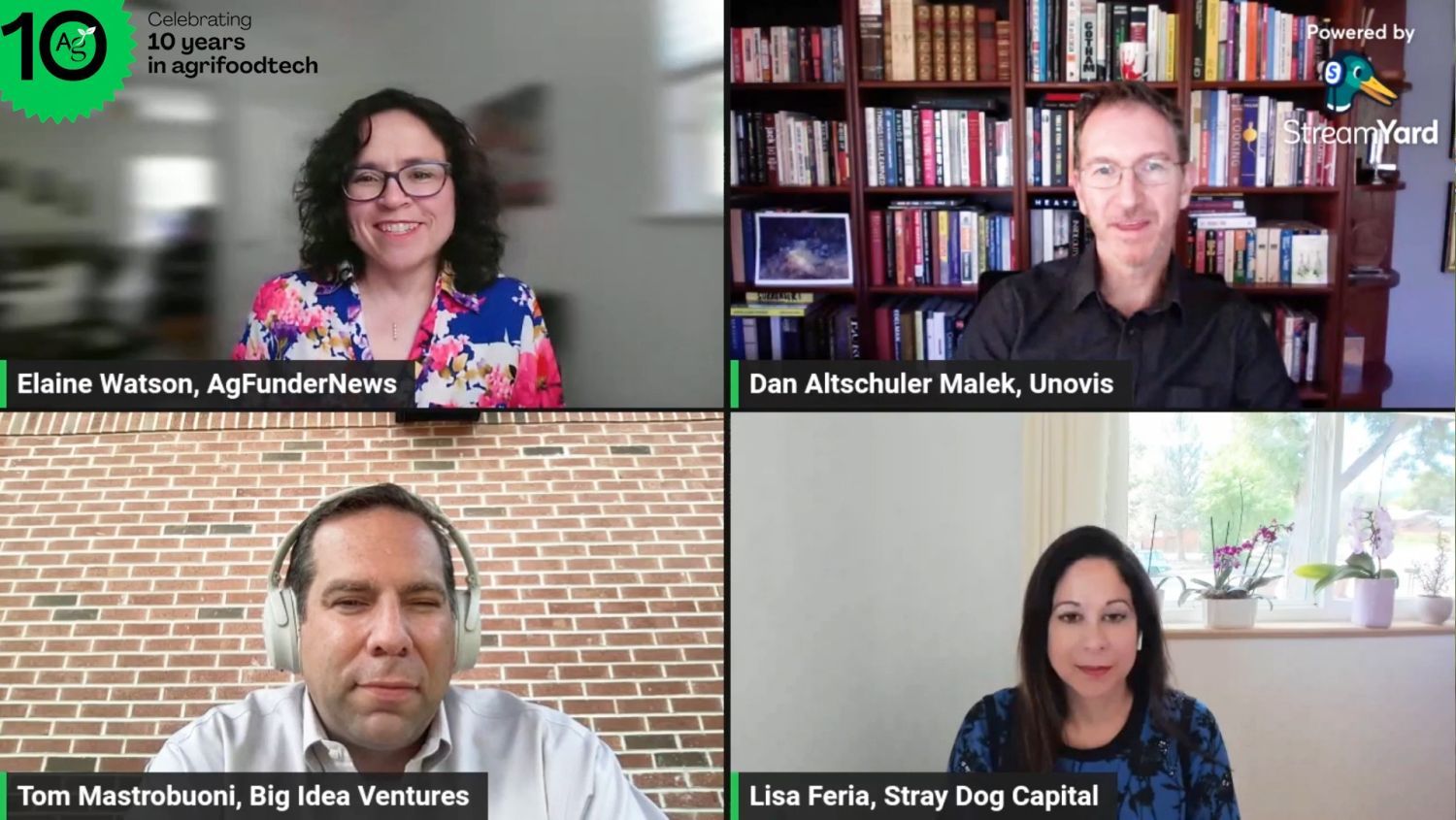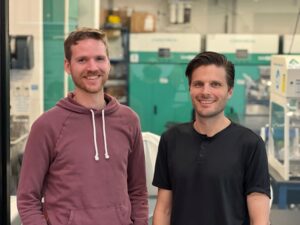Two or three years ago, investors were throwing bucket-loads of cash at foodtech companies, particularly those in so-called “alternative proteins.”
Since then, funding has started to dry up, sales of meat alternatives have moved into negative territory in some markets, and some commentators argue that we’ve already reached peak alt meat.
Meanwhile, some investors that used to be dedicated to alt proteins are now broadening their aperture to talk more about climate tech or food as medicine.
So has alt protein lost its luster for foodtech investors, or are we just seeing a much-needed correction after the heady days of cheap money, “tourist capital” and inflated valuations? AgFunderNews caught up with three investors specializing in alt protein to talk about funding past, present and future as AgFunder celebrates its 10th anniversary.
- Lisa Feria, CEO and managing partner, Stray Dog Capital
- Tom Mastrobuoni, chief investment officer, Big Idea Ventures
- Dan Altschuler Malek, managing partner, Unovis Asset Management
In our 45-minute conversation, we discussed:
- What’s happening in foodtech investing? Is the drop off in funding just mirroring other sectors or are specific dynamics at play?
- Why have there been so few exits in this space?
- Is money for solid alt protein startups still available or have we got to the stage where investors are turning off the tap and pivoting into adjacent segments?
- Have we already reached peak alt meat?
- Have we hit a wall when it comes to the technology underpinning alt meat, or is the recent market softening more reflective of macroeconomic factors and cultural barriers?
- To what extent is pricing holding back plant-based meat?
- Is the notion that alt meat is too “processed” or “unhealthy” really holding the market back?
- How confident is our panel that cultivated meat will take off?
- Do precision fermentation or plant cell culture approaches only work for high value ingredients like lactoferrin or cocoa polyphenols?
‘Tourist capital’ and dry powder:
Dan Altschuler Malek, Unovis: “When money became almost free three plus years ago, investors were looking at a lot of different spaces, and there was a run of we call ‘tourist capital’ from people that didn’t have a strong an understanding of the space, and they made a lot of investments. But one of the biggest challenges is that investing in food is a 7-10 year time horizon at the very least, and so we’re going through a reshuffling right now.
“In the very early days, there was inefficient use of resources. I don’t blame any individual company or person. I think it was just part of the ecosystem. There was so much money that to a certain extent founders had the expectation that 18 to 24 months down the line when they needed more money, more would just be available at a great valuation.”
Lisa Feria, Stray Dog Capital: “Venture capital tends to work in pendulums… and what we’re seeing now is the pendulum swinging in the other direction, whereas in the past few years, the pendulum swung very fast and very dramatically all the way to the right where we saw so much money from non-specific and non-expert investors in this space putting a lot of funds behind a lot of different companies and not really looking for sustainable business models or true points of difference.
“What we’re seeing now is an adjustment in the market. But the truth is that there’s so much dry powder in the venture capital world. Investors are holding back and pausing to see what’s happening with this market but also other markets that they have exposure to.
“There are still rounds that are oversubscribed… so companies continue to be attractive. There are strategics that are… demonstrating a long-term interest. For example, JBS just announced that it is building the largest cultivated meat facility in the world [although it shut down its Planterra plant-based meat division abruptly last year], so there’s still forward progress from a strategic side.
“What I am seeing recently is that strategics are de-risking a lot of these companies and then investors are coming in [whereas it’s] usually the other way round, where investors will gather around a high-potential company and then you’ll see strategics dip a toe in.
“We just invested in a company where two really large strategics were the ones leading the round, and then investors flocked in and the round ended up being oversubscribed, because they’re thinking, ‘Oh, these strategics are in play, this is a potential exit opportunity, they’re interested in the space and that lowers my risk.’
“Whereas I’ve seen with other companies, the expectation for investors is that [the startups are] delivering on their KPIs, they are increasing their revenues in a significant and sustainable way, [and investors are] adopting a wait and see situation where they’re saying, ‘Okay, well let’s talk in six months. Here’s the five things that I expect you to have been doing and have accomplished by then to make sure that you have a good product market fit, that you have a consumer problem that you’re solving.’
“I think some of the problems we’ve been seeing is that a lot of companies have been struggling because they don’t have a good consumer solution to a true consumer problem.”
Tom Mastrobuoni, Big Idea Ventures: “What we’re seeing now is not unlike what we’ve seen in other cycles with technology-based businesses; there’s fundamental tech and there’s a proliferation of brands that leverage that technology, and then there’s a calling of the herd into those that either have something truly unique or get gobbled up by larger players. And to Lisa’s point, we’re starting to focus a lot more on those sustainable business models… We need to look at margins, SG&A burn… we need to get away from this idea that we spend marketing dollars and consumers will come and buy our products. They did, but now they’re leaving and we need to figure out why.”
Is foodtech investment capital shifting away from alt proteins towards climate tech?
Dan Altschuler Malek, Unovis: “I would say it’s not so much shifting away, but also including all of the other challenges of food systems. We’re starting to do that, the reason being in the past seven years, we’ve seen a lot of the different pain points that our companies are coming across, be it in manufacturing, be it in raw materials, in processing.
“And those are true challenges that food companies, not just alt protein companies, are facing. So as it relates to being mindful of our investors, and being able to at the same time, improve the food system and bring about good returns, we need to have a broader bullseye. It’s not shying away from the ‘wrong’ thing, it’s about understanding that this is a larger ecosystem.”
Why are there so few exits in foodtech?
Dan Altschuler Malek, Unovis: “Is it realistic to think that there should have been more exits? That’s the question… [Do we have] outsized expectations? This is not a tech company where you’re going to scale it to 50 million, 100 million users in three years and then hand it off to an Oracle.
“Food takes a long time because you have the three-legged stool: manufacturing, distribution and demand, and you have to scale at a measured pace. Thinking that any brand is going to reach $50 million in sales in two years, it just does not make sense. You don’t have the capacity. You don’t have the relationships, you don’t have the demand.
“So I think it’s outside expectations that there haven’t been more profitable exits. I think what we’re seeing now is that there’s a lot of companies that are looking for ways to join forces, call it mergers, call it potential roll ups, where they are able to leverage their respective brands or products, but be able to share the overhead and the sales forces and then start to drive real demand.”
Have we already reached peak alt meat?
Tom Mastrobuoni, Big Idea Ventures: “We’re seeing a stagnation in product innovation… We have a proliferation of brands. And you end up spending more money on marketing dollars than you do on product R&D and you end up with stale products that aren’t changing.
“The same thing happened with the meal kit industry. It was a cool concept, but it turned into a fight for marketing dollars, the product quality suffered, and the supply chain wasn’t very well thought out. Same thing here. You have a highly fractured supply chain, multiple ingredients from different places. One place mixes, one place makes, one place called stores, one place distributes…
“We as food investors say well, you’re a food company, you should have mid-20s gross margin, but they don’t have a shot at getting there. I think there needs to be a return to the fundamentals of the product. We’re doing a lot more on the ingredient side, the infrastructure side, the formulation side from an investing perspective, to try and solve for some of those gaps.”
Dan Altschuler Malek, Unovis: “If you go back six, seven years, there was very limited awareness of vegan and plant based products, so we have come a long way… but companies need to improve their performance. The products need to improve. The labels need to get cleaner and we need to build consumer demand that is consistent. We need to understand what’s a false positive and what is a true consumer.”
Lisa Feria, Stray Dog Capital: “Pricing is an incredibly big factor… I mean many [meat alternative] products are anywhere from 25-40% more expensive by weight than the products that they’re trying to replace or compete with. And you have to deliver such a compelling argument in order for somebody to pay that much more. So even if [some consumers] had decided that once or twice a week they’re going to have a delicious Impossible Burger or Beyond Burger, they’re not going to be paying that 30% premium as often as they would in the past.
“I just had a company that sent me a whole muscle product that tasted amazing, but each time you eat those products, you have to spend $45, and how many times a week can the average person do that, no matter how tasty it is?
“And so you really have to hit those price points in order to become an every-day or every-other-day product that consumers are reaching for.”
The animal industry is heavily subsidized. Does the alt protein industry also need government money?
Dan Altschuler Malek, Unovis: “My hope would be that at some point in time, governments start to really show up. If we think about any industry, automotive, telecommunications, infrastructure, the US government has played a pivotal role, especially at the beginning, and they continue to do so in terms of the food industry, through subsidies of one sort or another.
“And I would hope that in particular for alt proteins, we start to see some sort of support in terms of capital expenditures, so that infrastructure can be built out that can be shared by the ecosystem, as well as in support for raw materials.”
Lisa Feria, Stray Dog Capital: “I think both strategics and government have a very important role to play because if you’re a strategic and the supply chain of one of your main product lines [is under threat], you need to find a solution now, so that when there’s a problem in 30 years’ time, you’re not losing revenue.
“And so they are self-motivated to find the best of the best [startups attempting to solve these structural problems] and push them along quickly, and ideally probably absorb them at some point. But governments also [will need to step in] because it will be a general issue when a lot of these crops that we’re all used to and love are not as available or are incredibly expensive because climate change has changed the game.”
Do the economics of cultivated meat make sense?
Lisa Feria, Stray Dog Capital: “I am very bullish about the cultivated meat category. We just invested in a company called Clever Carnivore, and they have been able, in a very short period of time, to climb up the cost curve so quickly that we’ve never seen this with almost any other company that we’ve talked to. So companies like that give us a lot of hope that technology could really help us jump [forward].
“Innovation is never a linear process… and there are so many different elements where new companies, new entrepreneurs, new ideas come in and really give a lot of gas to what we think is the final timeline, so I’ve seen enough [examples of that] lately that I feel like okay, maybe this is going to happen quicker than we all have been estimating?
“I mentioned JBS investing to build the largest cultivated facility in the world. They have to make money. So for them to have the confidence to do something like this means that the strategics are also invested in the success of that phase and that’s going to help build the bridge on the other side.”
Do consumers want cultivated meat?
Dan Altschuler Malek, Unovis: “Think about where organics were in the late 90s, when people were saying, ‘Why am I going to pay three times the amount for this apple?’ So it [cultivated meat] will also start out niche at a premium price point, but as these companies grow in scale, they’ll be able to lower their costs.”
What areas in foodtech do you believe are ripe for investment?
Dan Altschuler Malek, Unovis: “I think [alt] cheese and eggs continue to be categories I’m very excited about. Egg replacements provide so many benefits for food manufacturers and foodservice operators as well as consumers… so I think that category is ripe for continued disruption.
“Looking ahead [I expect to see more investment] across the whole value chain from ingredients to manufacturing, waste reduction in particular in the different parts of the supply chain, be it cold storage, increased shelf life, by natural means, and also in improved nutrition. I think less money will go into CPG and I think that is what’s going to be penalized because investors are going to say it takes a lot of money just to build a brand, so let’s see something else.”
Lisa Feria, Stray Dog Capital: “I continue to be excited about [alt] seafood, so having fantastic seafood replacements that meet consumers’ needs is going to be really important in the next 5-10 years. In terms of specific categories and companies, I’m still very excited about cultivated meat and Clever Carnivore is a company to watch out for.
“I think companies that really have a competitive advantage as it relates to technology that can be applicable to different product lines or markets are really interesting and attractive… and we’re going to continue to see companies that are built on a lot of fundamentals and that deliver on their numbers consistently in order to continue to get investment. But we expect to start seeing the [alt protein] category grow again because the fundamentals continue to be there from a generational standpoint, from a climate standpoint… and so we expect the market to start swinging back.”
















